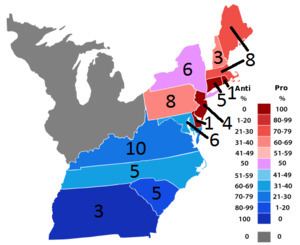December 22, 1788 - March 5, 1789 1790 → Start date 1789 | 37 28 | |
 | ||
Speaker before election
None Elected Speaker
Frederick Muhlenberg
Pro-Administration Winner Frederick Muhlenberg | ||
Elections to the United States House of Representatives for the 1st Congress were held in 1788 and 1789, coinciding with the election of George Washington as first President of the United States. The dates and methods of election were set by the states. Actual political parties did not yet exist, but new members of Congress were informally categorized as either "pro-Administration" (i.e., pro-Washington and pro-Hamilton) or "anti-Administration".
Contents
- Election summaries
- End of the 1st Congress
- Complete returns
- Delaware
- Georgia
- Maryland
- Massachusetts
- New Hampshire
- New Jersey
- New York
- Pennsylvania
- South Carolina
- Virginia
- References
The first session of the first House of Representatives came to order in Federal Hall, New York City on March 4, 1789, with only thirteen members present. The requisite quorum (thirty members out of fifty-nine) was not present until April 1, 1789. The first order of business was the election of a Speaker of the House. On the first ballot, Frederick Muhlenberg was elected Speaker by a majority of votes. The business of the first session was largely devoted to legislative procedure rather than policy.
Election summaries
In the 18th and much of the 19th century, each state set its own date for elections. In many years, elections were even held after the legal start of the Congress, although typically before the start of the first session. In the elections for the 1st Congress, five states held elections in 1788, electing a total of 29 Representatives, and six held elections in 1789, electing a total of 30 Representatives. Two states, North Carolina and Rhode Island, did not ratify the Constitution until November 21, 1789 and May 29, 1790 respectively, well after the Congress had met for the first time, and, consequently, elected representatives late, in 1790, leaving North Carolina unrepresented in the 1st session and Rhode Island in the 1st and 2nd sessions of a total of 3 sessions.
End of the 1st Congress
Six seats were filled late because North Carolina and Rhode Island ratified the Constitution late. One pro-Administration representative resigned and the seat remained open at the end of the Congress.
Complete returns
The states of North Carolina and Rhode Island ratified the Constitution late and thus elected representatives to the 1st Congress in 1790.
Delaware
Delaware had a single representative at this time. Under the law at the time, each voter cast two votes for representative, at least one of whom had to be from a different county.
Georgia
Georgia had a mixed at-large/district system for the 1st Congress. Representatives were elected at-large, but for three district-based seats.
Maryland
At the time, Maryland had a mixed district/at-large system similar to Georgia's. Under Maryland law, "candidates were elected at-large but had to be residents of a specific district with the statewide vote determining winners from each district."
Massachusetts
Massachusetts required a majority vote, necessitating additional votes if no one won a majority. This was necessary in 4 of the districts.
New Hampshire
New Hampshire electoral law required a candidate to receive votes from a majority of voters for election (16.7% of votes). No candidate won such a majority on the first ballot, so a second election had to be held, on February 2, 1789
Benjamin West did not serve, resigning before the start of the 1st Congress. A special election was held to fill the resulting vacancy which was won by Abiel Foster (P)
New Jersey
The election of all four representatives was contested, but the records that explained the precise grounds on which the election was contested have been lost due to the burning of Washington in the War of 1812. It is known to have related to questions of regularity and procedure. All four representatives' elections were ruled valid.
New York
New York held elections to the 1st Congress on March 3 and 4, 1789. At the time, districts were unnumbered. They are retroactively numbered in this section.
Pennsylvania
Pennsylvania held elections to the 1st Congress on November 26, 1788. For this first election (and again in 1792 election for the 3rd Congress), Pennsylvania chose to elect all of its representatives on a single statewide general ticket, an attempt by the pro-Administration-majority legislature to prevent anti-Administration candidates from winning seats.
South Carolina
In the 1st district, William L. Smith (P)'s election was contested by David Ramsay (P) who claimed that Smith had not been a citizen for the required 7 years at the time of his election, the House Committee on Elections ruled in Smith's favor
Virginia
Theodorick Bland (A) of the 9th district died in office and a special election was held to fill the resulting vacancy, which elected William B. Giles (A).
